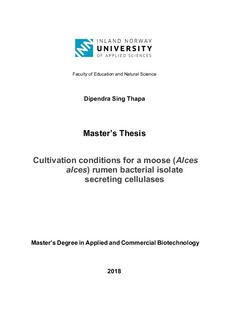| dc.description.abstract | The lignocellulosic biomass is the major carbon source in the nature, but is not easily degraded
because of its recalcitrant characteristic. The moose (Alces alces) primarily depends upon the
lignocellulosic biomass as feed during winter season. Although, lignocellulosic biomass has
recalcitrant properties, it is degraded and metabolized in the moose rumen and which
microorganisms take part in this process are interesting and is drawing the attention. A
cellulase secreting bacterial strain from moose rumen (MRB4) was used to evaluate its growth
characteristic and cellulolytic properties. The cellulose is not degraded directly by
microorganisms, but it is hydrolysed by the cellulolytic enzymes (cellulases) secreted by the
microorganisms. The enzymes are inducible by varieties of substances then secreted by
microorganisms. The cellulase is an enzyme complex (endoglucanase, exoglucanase and betaglucanase)
that act synergistically to degrade cellulose into its simple form, glucose. The main
goal of this study was to explore conditions for optimal growth and maximum enzyme
(CMCase) secretion with MRB4 using various supplements and response factors. The MRB4
isolates were cultured in both ABB media and LB media supplemented with Tween-20 and
either potato rasp or cellobiose as inducer. Carboxy methyl cellulose (CMC), CaCl2, and
temperature were tested as response factors in a fractional factorial Design of Experiments.
The effects of inducer and factors for optimal cell density and the CMCase activity were
analysed by reducing sugar assay and in zymography using CMC as substrate. Based on the
results obtained from the fermentation I and DoE design, the fermentation II was carried on
the basis of DoE for further confirmation. The possibility of capturing the enzyme from the
culture broth was also tested using mixed mode chromatography resin.
The cultivation performed in small scale and bench scale with CMC, cellobisoe, rasp revealed
that CMC only supported for increased cell density, but not CMCase activity, which decreased
after prolonged culture (24 hours). The cellobiose (0.5 %) had a positive effect on CMCasea
activity with maximum level after 9 to 12 hours of incubation, but not in cell density. Contour
plots from DoE analysis predicting optimal cell density and CMCase activity of MRB4 showed
that CaCl2 and CMC with concentration around 15 mg ml-1 and 1.5 % w/v respectively, can
enhance the cell density, while the highest CMCase activity can be obtained during higher
CaCl2 concentration (25 mg ml-1), but lower CMC concentration (0.25 % w/v). The effects
plots showed that CaCl2, CMC and temperature all had significant and positive effects on
bacterial growth although; the level of CMCase activity was very low. | nb_NO |
